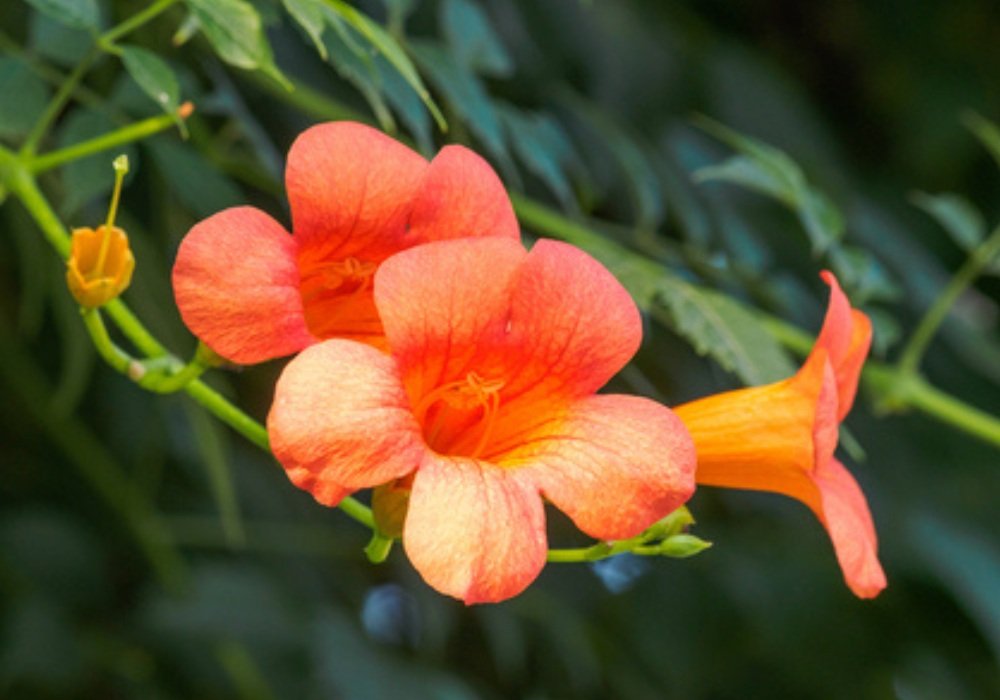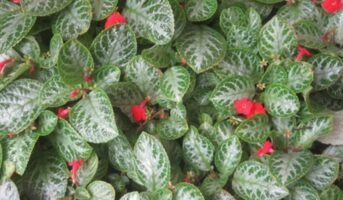Campsis grandiflora is a deciduous creeper that grows quickly and is often known as the Chinese trumpet vine. In the summer, this creeper has huge orange blooms styled like trumpets. It is more susceptible to frost damage than its close relative, Campsis radicans, which is found in East Asia.
Campsis grandiflora thrives best in soil that is both wet and nutrient-dense, as well as in a location that provides both full light and support for climbing.

Source: Pinterest
See also: Why is cape jasmine a flower of choice across Indian homes?
Campsis grandiflora: Key facts
| Scientific name | Campsis grandiflora |
| Common name | Chinese trumpet vine |
| Family | Bignoniaceae |
| Native region | China |
| Height | 6m- 9m |
| Soil pH | Acidic, Alkaline, Neutral |
| Bloom time | Spring, Summer |
| Maintenance | Medium |
Campsis grandiflora: Features
The Chinese trumpet creeper is a kind of deciduous creeper that grows quite swiftly. It features trumpet-shaped blooms that bloom in the summer and has dark green leaves whose margins are toothed. The flowers are the source of the plant’s name. These blooms come in a variety of orange tones, including coral, apricot, and a more traditional orange. The Chinese trumpet creeper has the potential to grow to a height of ten metres.
Campsis grandiflora: Growing tips
- Campsis can be planted between the fall and the spring, provided that the ground does not become frozen or waterlogged.
- Campsis can be grown as a border plant at the foot of a substantial wall, pergola, or other solid structure.
- It can also be planted close to a huge tree so that it will grow up through the branches of that tree.
- It is also possible to cultivate Campsis in a large container up against a wall or some other sturdy support.
- Because Campsis is such an active climber, the support has to be at least 4 metres (13 feet) in height.
- Even though it can withstand harsh weather, Campsis needs protection from the wind and full light in order to fully develop its wood and produce many blossoms.
- It thrives in any soil that is somewhat rich, slightly damp and has good drainage.
- Potting compost that is rich in loam should be placed within the container.
- To facilitate better drainage, you may add some more perlite or grit.
Growing by propagation
- Layering or taking semi-ripe, hardwood, or root cuttings is the most efficient method for propagating campsis.
- Rooted sucker that grows from the base can be severed from the parent plant and potted up on its own, once large enough.
- Additionally, Campsis may be produced from seed. Small pots or trays of seed compost should be sown in the fall and then placed in a cold frame to germinate and thrive. Growing from seed can be a sluggish process since germination can take many months, and blossoming might take several years.
Campsis grandiflora: Maintenance tips
- Campsis has moderate tolerance for drought, but when it is first planted or when it is growing in a container, it has to be watered often during periods of dry weather. Even plants that are well-established can benefit from additional watering during extended periods of drought.
- Unless it is cultivated in poor soil (such as shallow chalky soil) or in a container, Campsis does rather well on its own without the need for any further feeding.
- If it is essential, feed the plant with a general-purpose fertiliser in early spring at a rate of roughly 70 grams per square metre.
- To stimulate the production of flowers in container-grown plants, a liquid feed high in potassium, such as tomato fertiliser, can be used.
- Every spring and fall, spread a thick layer of mulch, such as garden compost, over the area where the plant’s roots are located. This will assist the soil to retain more moisture.
- Because older plants have the potential to get quite huge (up to 10 metres or 30 feet high), it is preferable to trim them on an annual basis in order to maintain a size that is more manageable.
- Plants that have become unmanageable can be severely pruned.

Source: Pinterest
Campsis grandiflora: Uses
Medicinal Uses
- The blooms and the whole plant have blood tonic, carminative, anti-oxidant, fever relieving, and diuretic properties,
- They are utilised in the therapy of several issues that are exclusive to women. It is possible to treat menstruation problems, rheumatic pains, traumatic injuries, difficult urination, pruritus, and weeping dermatophytosis using a decoction made from the flowers.
Garden Uses
- The Chinese trumpet creeper is most commonly planted in rockeries and yard shelves; nevertheless, it is also useful as a material for vertical greening.
- In gardens, it plays a vital role as a pollinator. It is highly regarded for its superiority as a vine that thrives in locations that receive direct sunlight, such as walls, arbours, fences, and trellises, where it displays colourful blossoms.
- It works well in both Mediterranean and cottage gardens, and it is frequently used with New England asters and yellow loosestrife since the complementary flowers of those two plants look great together.

Source: Pinterest
Common problems with Chinese Trumpet Creeper
In case of the Chinese Trumpset Creeper, during the summer season, the leaves may become yellow and diseased. Once the leaves turn yellow, they can’t be restored. However, it’s important for the leaves to be pruned because otherwise they will impact growth of the plant. Once you prune the yellow leaves, the plant gets more ventilation and grows faster.
How to harvest Chinese Trumpet Creeper?
You can harvest the Chinese Trumpet Creeper when the pod is brown in colour and is dry. It’s advisable to use gloves while harvesting so that the plant’s sap does not come in contact with your hand leading to irritation. Crack open the pods and remove the seeds. Dry them for 10 days and then plant them.
How to propagate Chinese Trumpet Creeper?
To propagate trumpet vine in water, take a cutting from the Chinese Trumpet Creeper vine and place it in a bowl of water. Ensure that the end which has a cut is inside the water. This is where the roots will grow.Change the water frequently so that trumpet vine gets good nutrition. Finally, when the roots emerge, you can transplant the Chinese Trumpet Creeper vine in soil.
FAQs
What is the sowing temperature for the seeds?
The seeds of Campsis grandiflora are sown in a greenhouse at 10 degree Celsius.
What colours are the flowers of Campsis?
These flowers range in orange hues, including coral, apricot and true orange.
Is the Chinese trumpet vine poisonous?
Trumpet vine is mildly toxic to both humans and animals, and its sap can cause skin irritation.
Housing News Desk is the news desk of leading online real estate portal, Housing.com. Housing News Desk focuses on a variety of topics such as real estate laws, taxes, current news, property trends, home loans, rentals, décor, green homes, home improvement, etc. The main objective of the news desk, is to cover the real estate sector from the perspective of providing information that is useful to the end-user.
Facebook: https://www.facebook.com/housing.com/
Twitter: https://twitter.com/Housing
Email: [email protected]











